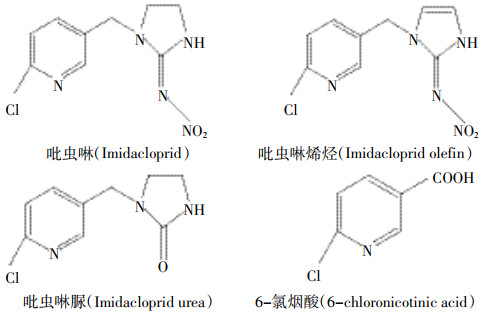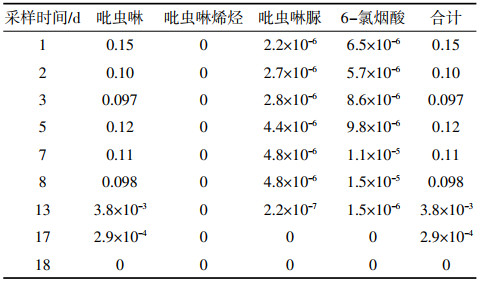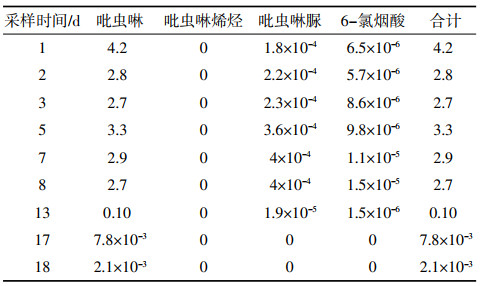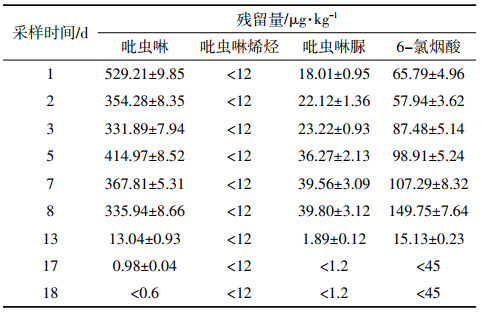文章信息
- 梁秀美, 王祥云, 汪志威, 齐沛沛, 王新全, 王强
- LIANG Xiu-mei, WANG Xiang-yun, WANG Zhi-wei, QI Pei-pei, WANG Xin-quan, WANG Qiang
- 茶园花期用药后蜂花粉中吡虫啉及其代谢物残留的蜜蜂风险评估
- Residues of imidacloprid and its metabolites in pollen, and exposure assessment for honey bees after spray application during the flowering period of tea
- 农业环境科学学报, 2018, 37(6): 1102-1107
- Journal of Agro-Environment Science, 2018, 37(6): 1102-1107
- http://dx.doi.org/10.11654/jaes.2017-1737
文章历史
- 收稿日期: 2017-12-20
- 录用日期: 2018-04-23
2. 省部共建国家重点实验室培育基地"浙江省植物有害生物防控重点实验室", 农业部农药残留检测重点实验室, 浙江省农业科学院农产品质量标准研究所, 杭州 310021;
3. 中国农业大学理学院, 北京 100094;
4. 温州科技职业学院分析测试中心, 温州 325006
2. State Key Lab Breeding Base for Zhejiang Sustainable Plant Pest Control; MOA Key Lab for Pesticide Residue Detection; Institute of Quality and Standard for Agro-products, Zhejiang Academy of Agricultural Sciences, Hangzhou 310021, China;
3. College of Science, China Agricultural University, Beijing 100094, China;
4. Analysis Test Center, Wenzhou Vocational College of Science and Technology, Wenzhou 325006, China
自然界90%的开花植物和75%的普通作物授粉依赖于昆虫传粉,且主要由蜜蜂完成。因此,蜜蜂对于保障食物供给和生物多样性具有重要意义[1-2]。近年来,欧美地区蜂群数量出现了持续下滑,尤其是2006年冬“蜂群衰竭失调症”(Colony Collapse Disorder,CCD)的爆发,引起了社会各界的高度关注[3]。栖息地的减少和碎片化、蜜粉源植物的减少、病原菌、气候变化、农药的大量使用等因素被认为是蜜蜂等授粉昆虫减少的主要原因[4-5]。其中,吡虫啉等新烟碱类农药被认为对蜜蜂具有特殊的不良影响[6-9]。为此,欧盟于2013年对吡虫啉等3种烟碱类农药实施了为期两年的临时限令,禁止其在油菜等蜜粉源作物上使用[10]。
茶树是我国秋季重要的蜜粉源植物,2015年国家统计数据显示全国茶园面积达279万hm2[11]。茶树具有泌蜜多、花粉丰富的特点,对蜂群秋季繁殖与组织生产十分有利[12-14]。然而,茶树于秋茶生产末期开花,由于气候等原因,秋茶生产中虫害发生较重,吡虫啉等杀虫剂残留问题较为突出。2016年绿色和平组织公布的调查报告显示,20批次非生态茶叶中16批次检出吡虫啉残留,残留量为0.017~0.387 mg·kg-1[15]。虽然茶花粉中吡虫啉的残留情况尚无相关报道,但其他作物施用吡虫啉后,其花粉中吡虫啉及其代谢物残留检出情况极为普遍[16-18]。吡虫啉及其代谢物具有较强内吸性,可通过植物韧皮部或木质部传导至作物各部分,从而导致蜜露和花粉中存在相应残留,这也是欧盟禁止吡虫啉在油菜、向日葵等蜜粉源作物上使用的主要原因之一。因此,茶树施用吡虫啉无疑将导致茶花粉中存在吡虫啉及其代谢物残留。
农药对蜜蜂的风险评估主要包括危害商(Hazard quotient,HQ)和暴露量/毒性(Exposure toxicity ratio,ETR)等不同方式。我国以及经济合作与发展组织(OECD)、联合国粮农组织(FAO)、欧洲和地中海植物保护组织(EPPO)等国际组织广泛采用危害商作为初级风险评估方式,其中欧洲食品安全局(EFSA)还进一步采用急性经口LD50、成蜂致畸LC50和幼蜂最大无作用剂量(NOEC)等数据计算相应ETR,以进一步评价农药使用的蜜蜂风险[19-23]。然而现有吡虫啉对蜜蜂的风险评估仅限于吡虫啉母体,其代谢物残留尚未涉及。Suchail等[24]的研究结果表明,吡虫啉的烯烃代谢物等具有与其母体相似的蜜蜂毒性,因此在评估茶花蜂花粉中吡虫啉残留对蜜蜂的风险时应涵盖其代谢物残留的影响。本实验通过茶树花期用药的方式,评估吡虫啉及其代谢物对蜜蜂的风险情况,以期为吡虫啉在茶树上的合理使用提供参考依据。吡虫啉及其部分代谢物的化学结构式如图 1所示。

|
| 图 1 吡虫啉及其部分代谢物结构式 Figure 1 The structure of imidacloprid and its metabolites |
茶树:龙井43。
意大利蜜蜂(Apis mellifera L.):由义乌市佛堂镇养蜂专业户提供,全部实验用蜂均为健康蜂。
1.2 田间试验设计参照《2013年的浙江省茶树病虫害防治药剂名单》的施用剂量[25],于2015年10月10日—11月10日在浙江省绍兴市富盛镇御茶村茶叶有限公司茶园(简称茶园),进行田间模拟试验。
茶园中部设4座防虫网大棚以控制蜜蜂采集范围,每棚0.067 hm2,其中1座为空白对照,其余3座用于模拟实验,大棚间间隔2 m。施药前5 d将蜂箱放入大棚内,让蜂群提前适应环境,每个大棚放置2箱蜂(约2×5000只)。待蜜蜂归巢后,关闭巢门并以塑料布覆盖蜂箱,防止药液沾染蜜蜂。随后,以喷雾器喷施10%吡虫啉可湿性粉剂2000倍液1次(有效成分11.5 g·hm-2)。施药后第1、2、3、5、7、8、13、17、18 d采集蜂花粉样品。蜂花粉样品通过巢门处的蜂花粉采集器脱取。由于气候原因,未能获得蜂蜜样品。样品采集后,于车载冰箱中冷藏保存,并尽快送至试验室,-18 ℃保存待测。
1.3 样品检测样品检测方法详见文献[26],概述如下:5 g蜂花粉样品中依次加入10 mL水和10 mL 5%甲酸乙腈溶液,涡旋混匀后加入6 g无水硫酸镁和1.5 g氯化钠,手动剧烈振摇30 s,离心取上清液;下层样品再加5 mL 5%的甲酸乙腈溶液重复提取一次,合并提取液,待净化。取5 mL合并后的提取液,以EMR净化管净化,离心取上清液。上清液以无水硫酸镁干燥后,用水稀释1倍,经0.22 μm滤膜过滤后,LC-MS/MS测定。蜂花粉中吡虫啉及其代谢物吡虫啉烯烃、吡虫啉脲、6-氯烟酸的定量限分别为0.6、12、1.2、45 μg·kg-1,检测限分别为0.2、4、0.4、14 μg·kg-1。在定量限、5倍定量限和10倍定量限的添加水平下,方法回收率在85.9%~107%之间,相对标准偏差低于8.2%。
1.4 数据处理按1.3节样品检测方法,对采集的蜂花粉样品进行检测,得出相应结果,并用Excel软件进行分析。
1.5 风险评价方法 1.5.1 危害商(HQ)本文采用《NY/T 2882.4—2016农药登记环境风险评估指南第4部分:蜜蜂》对蜜蜂的危害商进行评估,结果表述为风险商值[19]。在喷施场景下,采用喷施农药暴露场景的风险商值对蜜蜂进行初级风险评估。
风险商值(RQsp)=AR/(LD50×50)
式中:AR为推荐的农药单次最高施用量(g·hm-2);LD50为经口或接触的蜜蜂半致死剂量(μg·只-1),吡虫啉对蜜蜂的急性接触毒性LD50为0.081 μg·只-1[27]。当RQsp≤1时,风险可接受;当RQsp>1时,风险不可接受,需进行高级风险评估[19]。
1.5.2 暴露量/毒性(ETR)ETR包括急性经口LD50、成蜂致畸LC50和幼蜂最大无作用剂量(NOEC)等多种评价内容[28]。本研究根据现有毒理学数据,开展了急性经口LD50和成蜂致畸LC50的ETR评价。
1.5.2.1 急性经口(ETRoral)成蜂急性经口ETRoral=RI/LD50oral
式中:LD50oral指经口致死中量(μg·只-1);RI为蜜蜂单日摄入的残留量(μg·只-1),可由蜂花粉中的残留量×蜜蜂单日摄食量计算所得,其中蜜蜂单日蜂花粉摄食量为0.012 g·只-1。LD50oral源于Nauen等[29]的试验数据,吡虫啉、吡虫啉烯烃、吡虫啉脲和6-氯烟酸分别为0.041、>0.036、>99.5 μg·只-1和>121.5 μg·只-1,参照ESFA计算规则直接以相应数值计算[29]。ETRoral域值为0.2,当数值>0.2时,则存在风险,应采取进一步的评估。
1.5.2.2 成蜂致畸(ETRchronic)成蜂致畸ETRchronic=RI/LC50
式中:LC50指经口致死中浓度(μg·L-1);RI为蜜蜂单日摄入的残留量(μg·只-1)。吡虫啉及其代谢物尚无LC50数据,因此在ESFA评价中建议采用NOEC值替代[27]。本研究采用Nauen等[29]的试验数据,吡虫啉、吡虫啉烯烃、吡虫啉脲和6-氯烟酸的NOEC值分别为0.001 5、0.002 4、1.2 μg·只-1和121.5 μg·只-1。ETRchronic域值为0.03,当数值>0.03时,则存在风险,应采取进一步的评估。
2 结果与分析 2.1 蜂花粉中吡虫啉及其代谢物残留情况蜂花粉中吡虫啉及其代谢物残留测定结果见表 1。药后1 d,吡虫啉浓度达529.21 μg·kg-1,同时吡虫啉脲和6-氯烟酸分别有18.01 μg·kg-1和65.79 μg·kg-1残留检出,但蜜蜂毒性相对较高的吡虫啉烯烃尚无检出。吡虫啉残留在药后13 d出现急剧降低,在试验最后1 d仍有0.26 μg·kg-1检出,但已低于0.6 μg·kg-1的定量限;吡虫啉烯烃则仅在药后3~8 d检出3.50~4.76 μg·kg-1,但均低于12 μg·kg-1的定量限;吡虫啉脲和6-氯烟酸均从药后第1 d逐渐升高,直至药后第8 d达到峰值,分别为39.80 μg·kg-1和149.75 μg·kg-1,至药后17 d两者均无检出。
本实验中吡虫啉的使用剂量为有效成分11.25 g·hm-2,而吡虫啉对蜜蜂的急性接触毒性LD50为0.081 μg·只-1。根据喷施农药暴露场景的RQsp,可得吡虫啉在茶树上使用的危害商为2.8,高于风险可接受阈值。即吡虫啉在茶树上的使用对蜜蜂具有不可接受的风险,需要进一步进行风险评估。
2.2.2 急性经口根据1.5.2.1的计算公式,结合表 1的蜂花粉中吡虫啉及其代谢物残留结果(平均值),蜂花粉中吡虫啉及其代谢物的急性经口ETRoral评价结果见表 2。从表 2结果可知,茶树花期用药后蜂花粉中吡虫啉及其代谢物残留急性经口风险最高为0.15,低于ESFA的0.2阈值,即急性经口风险可接受。此外,吡虫啉代谢物占总体风险比例较低,最高的药后8 d时的吡虫啉烯烃也仅占当日总风险的1.6%。

|
根据1.5.2.2的计算公式,结合表 1的蜂花粉中吡虫啉及其代谢物残留结果(平均值),蜂花粉中吡虫啉及其代谢物的急性经口ETRchronic评价结果见表 3。从表 3结果可知,茶树花期用药后蜂花粉中吡虫啉及其代谢物残留成蜂致畸风险最高为药后1 d,达4.2,远高于ESFA的0.03阈值,直到药后17 d ETRchronic才降至0.03以下,即具有极高的成蜂致畸风险。此外,吡虫啉代谢物占总体风险比例较低,相对较高的吡虫啉烯烃也仅占当日总风险的1%以下。

|
由于吡虫啉的广泛使用,世界各地蜂花粉中均检出不同程度的吡虫啉及其代谢物残留,但浓度跨度较大。法国2002—2004年的连续监测试验发现69%的蜂花粉样品中检出吡虫啉或其代谢物6-氯烟酸,残留量分别为1.1~5.7 μg·kg-1和0.6~9.3 μg·kg-1[30];美国2007—2008年的350份花粉中虽仅有2.9%的样品检出吡虫啉,但残留量最高达992 μg·kg-1[31];意大利2012—2014年采集的554份蜂花粉中12.5%样品检出吡虫啉,残留量为1~19 μg·kg-1[32]。土壤拌种、灌根和叶面喷雾等施药方式以及距离花期时间的不同,可能是导致蜂花粉中吡虫啉残留浓度差异的主要原因。Dively等[33]研究了不同施药条件下南瓜花粉中吡虫啉的残留情况,结果表明在移植3周滴灌给药后花粉中的残留量可达52.3~101 μg·kg-1,而苗床给药仅产生3.3~6.7 μg·kg-1的残留。由于国内外吡虫啉主要施药方式的差异,未能查询到吡虫啉花期叶面喷雾施药后花粉中的残留情况,但据现有的文献报导[33]推测吡虫啉花期叶面喷雾可能带来更大残留。因此,为保障蜂产品质量安全,应限制临近茶树花期时吡虫啉的使用,具体的安全间隔期仍需进一步的试验确认。
虽然蜂花粉等蜂产品中农药残留对蜜蜂风险评估已有部分报道[34-35],但基于权威性的考虑,本文最终采用欧盟官方机构EFSA的模型进行评估[27]。此外,在采用相同模型和阈值的情况下,不同来源数据的采用可能导致截然不同的评价结果。本文中,吡虫啉急性接触LD50采用EFSA评估报告所用的0.081 μg·只-1,评价结果与EFSA评价结果相同,均为不可接受;但急性经口LD50为与其代谢物数据相匹配,采用文献数据(0.041 μg·只-1),而EFSA采用0.003 7 μg·只-1,结果导致吡虫啉本次急性经口风险评价可接受,但EFSA评价结果为不可接受。
为得到更准确的评估结果,EFSA在风险评价过程中对各种不同施药场景采用不同系数计算农药暴露量。条件所限,本次评价中所用残留数据具有一定的局限性,更准确的评价需进一步开展大田试验。本场景中,采用防虫网封闭的方式使得蜜蜂仅能采集吡虫啉喷施后的蜂花粉样品,而且喷施时间为茶树始花期,相对实际情况而言,蜂花粉中吡虫啉残留易偏高。此外,茶树蜂花粉具有较高的经济价值,我国蜂农通常收集后用于贩卖,并不会任由蜜蜂食用,使得蜜蜂的实际暴露风险低于评价结果。然而,本实验中吡虫啉的使用剂量为11.25 g·hm-2,而目前中国农药信息网登记的吡虫啉在茶树上的最高推荐剂量为42 g·hm-2[36],比本实验高近3倍。若在山谷等半封闭环境内,吡虫啉按现有最高推荐剂量(42 g·hm-2)在茶树盛花期时使用,可能对蜜蜂带来较为严重的后果。因此,本文认为吡虫啉在茶树上叶面喷雾,至少在花期附近使用,对蜜蜂有一定的潜在风险,需进一步开展试验和风险评估以确保安全性。
4 结论(1)以风险商值(RQsp)进行初级风险评估时,吡虫啉在茶树上的使用对蜜蜂具有不可接受的急性接触风险。
(2)以ETR进行急性经口评估时,其茶树上的使用风险为可接受。
(3)以ETR进行成蜂致畸评估时,其茶树上的使用风险为药后前13 d不可接受。
(4)本次评价结果显示,吡虫啉对蜜蜂的风险绝大多数源于吡虫啉母体,占比超过98%。
| [1] |
Klein A M, Vaissière B E, Cane J H, et al. Importance of pollinators in changing landscapes for world crops[J]. Proceedings Biological Sciences, 2007, 274(1608): 303-313. DOI:10.1098/rspb.2006.3721 |
| [2] |
Ollerton J, Winfree R, Tarrant S. How many flowering plants are pollinated by animals?[J]. Oikos, 2011, 120(3): 321-326. DOI:10.1111/more.2010.120.issue-3 |
| [3] |
Johnson R. Recent honey bee colony declines[R]. Congressional Research Service Reports. 2007.
|
| [4] |
Potts S G, Biesmeijer J C, Kremen C, et al. Global pollinator declines:Trends, impacts and drivers[J]. Trends in Ecology & Evolution, 2010, 25(6): 345-353. |
| [5] |
Vanbergen A J. Threats to an ecosystem service:Pressures on pollinators[J]. Frontiers in Ecology & the Environment, 2013, 11(5): 251-259. |
| [6] |
蔺哲广, 孟飞, 郑火青, 等. 新烟碱类杀虫剂对蜜蜂健康的影响[J]. 昆虫学报, 2014, 57(5): 607-615. LIN Zhe-guang, MENG Fei, ZHENG Huo-qing, et al. Effects of neonicotinoid insecticides on honeybee health[J]. Acta Entomological Sinica, 2014, 57(5): 607-615. |
| [7] |
Decourtye A, Armengaud C, Renou M, et al. Imidacloprid impairs memory and brain metabolism in the honeybee(Apis mellifera L.)[J]. Pesticide Biochemistry and Physiology, 2004, 78(2): 83-92. DOI:10.1016/j.pestbp.2003.10.001 |
| [8] |
Cresswell J E. A meta-analysis of experiments testing the effects of a neonicotinoid insecticide(imidacloprid) on honey bees[J]. Ecotoxicology, 2011, 20(1): 149-157. DOI:10.1007/s10646-010-0566-0 |
| [9] |
Whitehorn P R, O'Connor S, Wackers F L, et al. Neonicotinoid pesticide reduces bumble bee colony growth and queen production[J]. Science, 2012, 336(6079): 351-352. DOI:10.1126/science.1215025 |
| [10] |
单蕾. 欧盟委员会颁布新烟碱类杀虫剂限令[J]. 农药科学与管理, 2013, 34(10): 9. SHAN Lei. European commission issued the restrictions of neonicotinoid insecticides[J]. Pesticide Science and Administration, 2013, 34(10): 9. |
| [11] |
中华人民共和国国家统计局. 国家数据: 2015年茶园面积[DB/OL]. [2018-02-09]. http://data.stats.gov.cn/easyquery.htm?cn=C01 National Bureau of Statistics of the People's Republic of China. National Data: The area of tea garden in 2015[DB/OL] [2018-02-09]. http://data.stats.gov.cn/easyquery.htm?cn=C01 |
| [12] |
单尧燕. 茶花期蜂群的管理[J]. 蜜蜂杂志, 1996(5): 13-14. SHAN Yao-yan. The management of bee colonies on tea treesbloom[J]. Journal of Bee, 1996(5): 13-14. |
| [13] |
罗建能. 浙江四明山区茶花期蜂群的管理[J]. 中国养蜂, 2003, 54(4): 13. LUO Jian-neng. The management of bee colonies on tea trees bloom in Zhejiang Siming district[J]. Apiculture of China, 2003, 54(4): 13. |
| [14] |
赵建航, 李海金, 吴国龙. 杭州地区蜜蜂小转地饲养管理技术[J]. 中国蜂业, 2007, 58(2): 18-19. ZHAO Jian-hang, LI Hai-jin, WU Guo-long. The small migratory feeding and management technology of honeybees in Hangzhou[J]. Apiculture of China, 2007, 58(2): 18-19. |
| [15] |
绿色和平组织. 2016年绿色和平茶叶农药调查报告[EB/OL]. [2018-02-09]. http://www.greenpeace.org.cn/2016-tea-pesticide-residue-report/Greenpeace. The greenpeace tea pesticide survey report of 2016[EB/OL]. [2018-02-09]. http://www.greenpeace.org.cn/2016-tea-pesticide-residue-report/Greenpeace. |
| [16] |
Stoner K A, Eitzer B D. Movement of soil-applied imidacloprid and thiamethoxam into nectar and pollen of squash(Cucurbita pepo)[J]. PloS One, 2012, 7(6): e39114. DOI:10.1371/journal.pone.0039114 |
| [17] |
Sánchez-Hernández L, Hernández-Domínguez D, Martín M T, et al. Residues of neonicotinoids and their metabolites in honey and pollen from sunflower and maize seed dressing crops[J]. Journal of Chromatography A, 2016, 1428: 220-227. DOI:10.1016/j.chroma.2015.10.066 |
| [18] |
David A, Botías C, Abdul-Sada A, et al. Widespread contamination of wildflower and bee-collected pollen with complex mixtures of neonicotinoids and fungicides commonly applied to crops[J]. Environment International, 2016, 88: 169-178. DOI:10.1016/j.envint.2015.12.011 |
| [19] |
中华人民共和国农业部. NY/T 2882. 4-2016农药登记环境风险评估指南第4部分: 蜜蜂[S]. 北京: 中国标准出版社, 2016. Ministry of Agriculture of PRC. NY/T 2882. 4-2016 Guidance on environment risk assessment for pesticide registration Part 4: Honeybees[S]. Beijing: China Standards Press, 2016. |
| [20] |
OECD(Organization for Economic Co-operation and Development). OECD guidance for industry data submissions on plant protection products and their active substances(revision2). Appendix 8, part 3, Ecotoxicological Studies and Risk Assessment[S]. Paris, France: OECD, 2005.
|
| [21] |
FAO(Food and Agriculture Organization of the United Nations). Revised guidelines on environmental criteria for the registration of pesticides. Part 2, guidelines for appropriate test procedures[S]. Rome, Italy: FAO, 1989.
|
| [22] |
EPPO(European and Mediterranean Plant Protection Organization). Guidelines for the efficacy evaluation of plant protection products.No.170:side effects on honeybees[J]. IOBC/WPRS Bulletin, 2000, 23: 51-55. |
| [23] |
EF SA. Conclusion on the peer review of the pesticide risk assessment for bees for the active substance imidacloprid[J]. EFSA Journal, 2013, 11(1): 3068. DOI:10.2903/j.efsa.2013.3068 |
| [24] |
Suchail S, Guez D, Belzunces L P. Discrepancy between acute and chronic toxicity induced by imidacloprid and its metabolites in apis mellifera[J]. Environmental Toxicology and Chemistry, 2001, 20(11): 2482-2486. DOI:10.1002/etc.v20:11 |
| [25] |
浙江省农业厅. 2013年浙江省主要农作物病虫草害防治药剂推荐名单[EB/OL]. [2018-02-09]. http://www.zj.gov.cn/art/2013/5/28/art_5528_725535.html Zhejiang Province Agriculture Department. The recommend list of pesticides for major crops in Zhejiang Province 2013. [EB/OL]. [2018-02-09]. http://www.zj.gov.cn/art/2013/5/28/art_5528_725535.html |
| [26] |
梁秀美, 王祥云, 薛晓锋, 等. 液相色谱-串联质谱法测定蜂产品中吡虫啉及其3种代谢物[J]. 分析化学, 2017, 45(4): 553-559. LIANG Xiu-mei, WANG Xiang-yun, XUE Xiao-feng, et al. Determination of imidaclopridand its three metabolites in honey and bee pollen by liquid chromatography-tandem mass spectrometry[J]. Analytical Chemistry, 2017, 45(4): 553-559. DOI:10.11895/j.issn.0253-3820.160833 |
| [27] |
EFSA. Conclusion on the peer review of the pesticide risk assessment for bees for the active substance imidacloprid considering all uses other than seed treatments and granules[J]. Efsa Journal, 2015, 13(8): 4211. DOI:10.2903/j.efsa.2015.4211 |
| [28] |
EFSA. Guidance on the risk assessment of plant protection products on bees(Apis mellifera, Bombus spp.and solitary bees)[J]. Efsa Journal, 2013, 11(7): 3295. DOI:10.2903/j.efsa.2013.3295 |
| [29] |
Nauen R, Ebbinghaus-Kintscher U, Schmuck R. Toxicity and nicotinic acetylcholine receptor interaction of imidacloprid and its metabolites in Apis mellifera(Hymenoptera:Apidae)[J]. Pest Management Science, 2001, 57(7): 577-586. DOI:10.1002/(ISSN)1526-4998 |
| [30] |
Chauzat M, Faucon J A, Lachaize J, et al. A survey of pesticide residues in pollen loads collected by honey bees in France[J]. Journal of Economic Entomology, 2006, 99(2): 253-262. DOI:10.1093/jee/99.2.253 |
| [31] |
Mullin C A, Frazier M, Frazier J L, et al. High levels of miticides and agrochemicals in North American apiaries:Implications for honey bee health[J]. PloS One, 2010, 5(3): e9754. DOI:10.1371/journal.pone.0009754 |
| [32] |
Tosi S, Costa C, Vesco U, et al. A 3-year survey of Italian honey bee-collected pollen reveals widespread contamination by agricultural pesticides[J]. Science of the Total Environment, 2017, 615: 208-218. |
| [33] |
Dively G P, Kamel A. Insecticide residues in pollen and nectar of a cucurbit crop and their potential exposure to pollinators[J]. Journal of Agricultural and Food Chemistry, 2012, 60(18): 4449-4456. DOI:10.1021/jf205393x |
| [34] |
Sanchez-Bayo F, Goka K. Pesticide residues and bees:A risk assessment[J]. PloS One, 2014, 9(4): e94482. DOI:10.1371/journal.pone.0094482 |
| [35] |
Lawrence T J, Culbert E M, Felsot A S, et al. Survey and risk assessment of Apis mellifera(Hymenoptera:Apidae) exposure to neonicotinoid pesticides in urban, rural, and agricultural settings[J]. Journal of Economic Entomology, 2016, 109(2): 520-528. DOI:10.1093/jee/tov397 |
| [36] |
中华人民共和国农业部农药检定管理所. 农药登记数据库: 茶上吡虫啉登记数据[DB/OL]. [2018-02-09]. http://www.chinapesticide.org.cn/hysj/index.jhtml Institute for the Control of Agrochemicals, MOA. Pesticide registration data base: Imidacloprid registered on teas[DB/OL]. [2018-02-09]. http://www.chinapesticide.org.cn/hysj/index.jhtml |
 2018, Vol. 37
2018, Vol. 37





